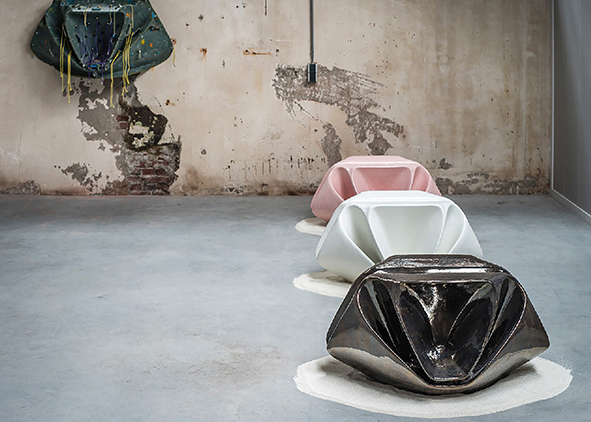Forming digital kinships with earthen materials. The T-Stool
DOI:
https://doi.org/10.19229/2464-9309/10212021Keywords:
ceramics, structure as design, digital twin, press-molding, silicone rubber moldsAbstract
This paper aims to address how the ceramic process has been conceptualized to develop a new kinship between ceramic and its counterparts through digital technology. The interface between ceramic materials and digital fabrication, outlined here initiates a new collaboration between the real and the digital, whose interactions are tentacular. The design framework aims to rigorously leverage the vibrancy of matter in the design process. The methodology chronicles the fabrication of the T-Stool, as part of interdisciplinary collaboration, to develop a novel press-molding technique for stoneware that uses a two-part, silicone rubber and epoxy mold. The T-Stool was executed in stoneware through the use of a digital twin as a data source for material speculation, to track transformations in the clay, and to implement the use of custom tools.
Downloads
Article Metrics Graph
References
Bechthold, M., Kane, A. and King, N. (2015), Ceramic Material Systems – In Architecture and Interior Design, Birkhäuser, Basel.
Bennett, J. (2010), Vibrant Matter – A Political Ecology of Things, Duke University Press, Durham (US).
Canguilhem, G. (1992), “Machine and Organism”, in Crary, J. and Kwinter, S. (eds), Incorporations, Zone Books, New York.
Carty, W. M. (2019), Energy in Terra Cotta – The Balance Between Heat Storage and Strength, lecture in Architectural Ceramic Assemblies Workshop, August 12, 2019. [Online] Available at: archceramicworkshop.com/lectures/ [Accessed 05 November 2021].
Easterling, K. (2021), Medium Design – Knowing How to Work on the World, Verso, London.
Fisher, J. (2005), “Making the Link – Persuasion and Permanence”, in Reijnders, A. and European Ceramic Work Center (eds), The Ceramic Process – A Manual and Source of Inspiration for Ceramic Art and Design, University of Pennsylvania Press, Philadelphia, pp. 7-9.
Garcia, T. (2014), Form and Object – A Treatise on Things, Edinburgh University Press, Edinburgh.
Gorter, H. (2005), “Material method and process”, in Reijnders, A. and European Ceramic Work Center (eds), The Ceramic Process – A Manual and Source of Inspiration for Ceramic Art and Design, University of Pennsylvania Press, Philadelphia, pp. 17-21.
Grieves, M. W. (2019), “Virtually Intelligent Product Systems – Digital and Physical Twins”, in Flumerfelt, S., Schwartz, K. G., Mavris, D. and Briceno, S. (eds), Complex Systems Engineering – Theory and Practice, American Institute of Aeronautics and Astronautics, Reston (US), pp. 175-200. [Online] Available at: doi.org/10.2514/5.9781624105654.0175.0200 [Accessed 26 October 2021].
Haraway, D. J. (2016), Staying with the Trouble – Making Kin in the Chthulucene, Duke University Press, Durham (US).
Harman, G. (2011), The Quadruple Object, Zero Books, Winchester (UK).
Iten, C. (2008), “Ceramics Mended with Lacquer – Fundamental Aesthetic Principles, Techniques and Artistic Concepts”, in Herbert, F. and Johnson Museum of Art (eds), Flickwerk – The Aesthetics of Mended Japanese Ceramics, Museum für Lackkunst, pp. 18-24. [Online] Available at annacolibri.com/wp-content/uploads/2013/02/Flickwerk_The_Aesthetics_of_Mended_ Japanese_Ceramics.pdf [Accessed 05 November 2021].
May, J. (2017), “Everything Is Already an Image”, in Log, n. 40, pp. 9-26. [Online] Available at: jstor.org/stable/26323867 [Accessed 26 April 2021].
Reijnders, A. and European Ceramic Work Center (eds) (2005), The Ceramic Process – A Manual and Source of Inspiration for Ceramic Art and Design, University of Pennsylvania Press, Philadelphia.
Russo, R. and Mueller-Russo, K. (2012), “Textiles – Alternate Forms of Malleability”, in Studies in Material Thinking, vol. 7, pp. 1-9. [Online] Available at: materialthinking.org/sites/default/files/papers/SMT_V7_P9_ Russo_and_Russo.pdf [Accessed 26 April 2021].
Sentance, B. (2004), Ceramics – A World Guide to Traditional Techniques, Thames & Hudson, London.

Downloads
Published
How to Cite
Issue
Section
License
This Journal is published under Creative Commons Attribution Licence 4.0 (CC-BY).
License scheme | Legal code
This License allows anyone to:
Share: copy and redistribute the material in any medium or format.
Adapt: remix, transform, and build upon the material for any purpose, even commercially.
Under the following terms
Attribution: Users must give appropriate credit, provide a link to the license, and indicate if changes were made; users may do so in any reasonable manner, but not in any way that suggests the licensor endorses them or their use.
No additional restrictions: Users may not apply legal terms or technological measures that legally restrict others from doing anything the license permits.
Notices
Users do not have to comply with the license for elements of the material in the public domain or where your use is permitted by an applicable exception or limitation.
No warranties are given. The license may not give users all of the permissions necessary for their intended use. For example, other rights such as publicity, privacy, or moral rights may limit how you use the material.


















































































